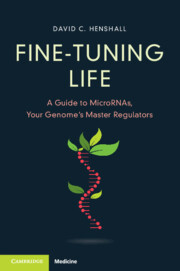Book contents
- Fine-Tuning Life
- Reviews
- Fine-Tuning Life
- Copyright page
- Dedication
- Contents
- Figures
- Ode to the MicroRNA
- Acknowledgements
- Common Terms and Definitions
- Introduction
- Chapter 1 Discovered!
- Chapter 2 MicroRNAs Emerge as Master Controllers
- Chapter 3 Epic Journey
- Chapter 4 Opening Act
- Chapter 5 MicroRNAs Shape the Machinery of Our Minds
- Chapter 6 Centre of the Electrical Storm
- Chapter 7 MicroRNAs Become Medicines
- Chapter 8 Circulating MicroRNAs Provide a Diagnosis
- Chapter 9 Finale and Encore for MicroRNAs
- References
- Index
Chapter 1 - Discovered!
A New Regulator of Gene Activity
Published online by Cambridge University Press: aN Invalid Date NaN
- Fine-Tuning Life
- Reviews
- Fine-Tuning Life
- Copyright page
- Dedication
- Contents
- Figures
- Ode to the MicroRNA
- Acknowledgements
- Common Terms and Definitions
- Introduction
- Chapter 1 Discovered!
- Chapter 2 MicroRNAs Emerge as Master Controllers
- Chapter 3 Epic Journey
- Chapter 4 Opening Act
- Chapter 5 MicroRNAs Shape the Machinery of Our Minds
- Chapter 6 Centre of the Electrical Storm
- Chapter 7 MicroRNAs Become Medicines
- Chapter 8 Circulating MicroRNAs Provide a Diagnosis
- Chapter 9 Finale and Encore for MicroRNAs
- References
- Index
Summary
The process of how we get from gene to protein is one of the most intensely studied and best understood in biology. The reading of DNA, the generation of a messenger ribonucleic acid (mRNA) and the translation of that transcript into a protein through assembling chains of amino acids. But what we thought we knew about the gene pathway changed forever in 1993, when Gary Ruvkun and Victor Ambros discovered microRNAs. This chapter begins by explaining the basic biochemistry of genes and proteins before moving on to the seminal work of 30 years ago. The objective of those experiments was to understand which genes controlled the timing of animal development in a worm called Caenorhabditis elegans. That led to the realisation that a gene called lin−4, crucial for worms to transition from juvenile to adult stages, did not code for a protein; instead, its RNA acted by sticking to the mRNA of a protein-coding gene. Lin−4 was a gene silencer, working to lower the amounts of protein in cells. The finding of a new step on the journey from gene to protein would go on to transform our understanding of the biology of living organisms.
Keywords
- Type
- Chapter
- Information
- Fine-Tuning LifeA Guide to MicroRNAs, Your Genome's Master Regulators, pp. 5 - 19Publisher: Cambridge University PressPrint publication year: 2024



